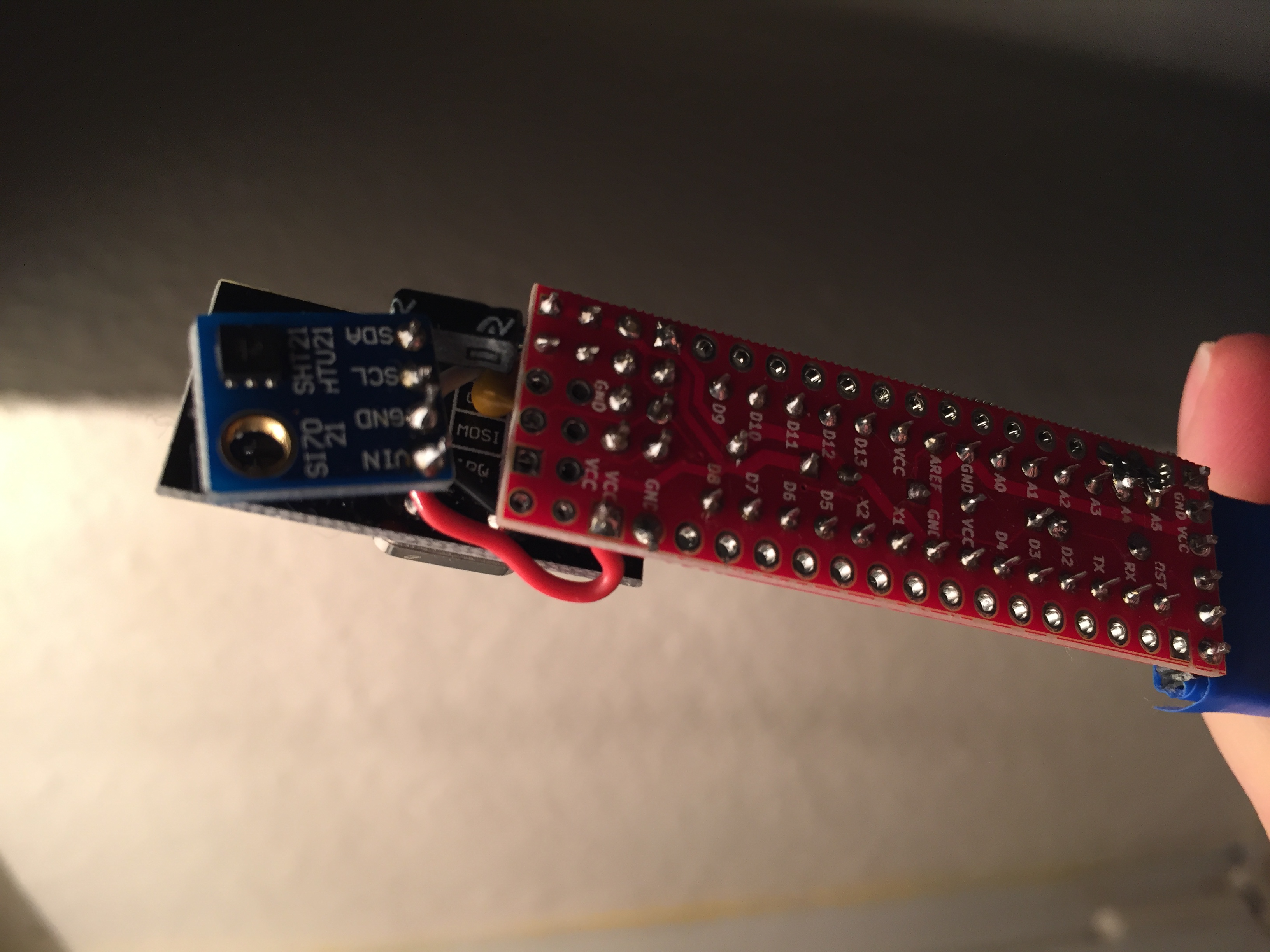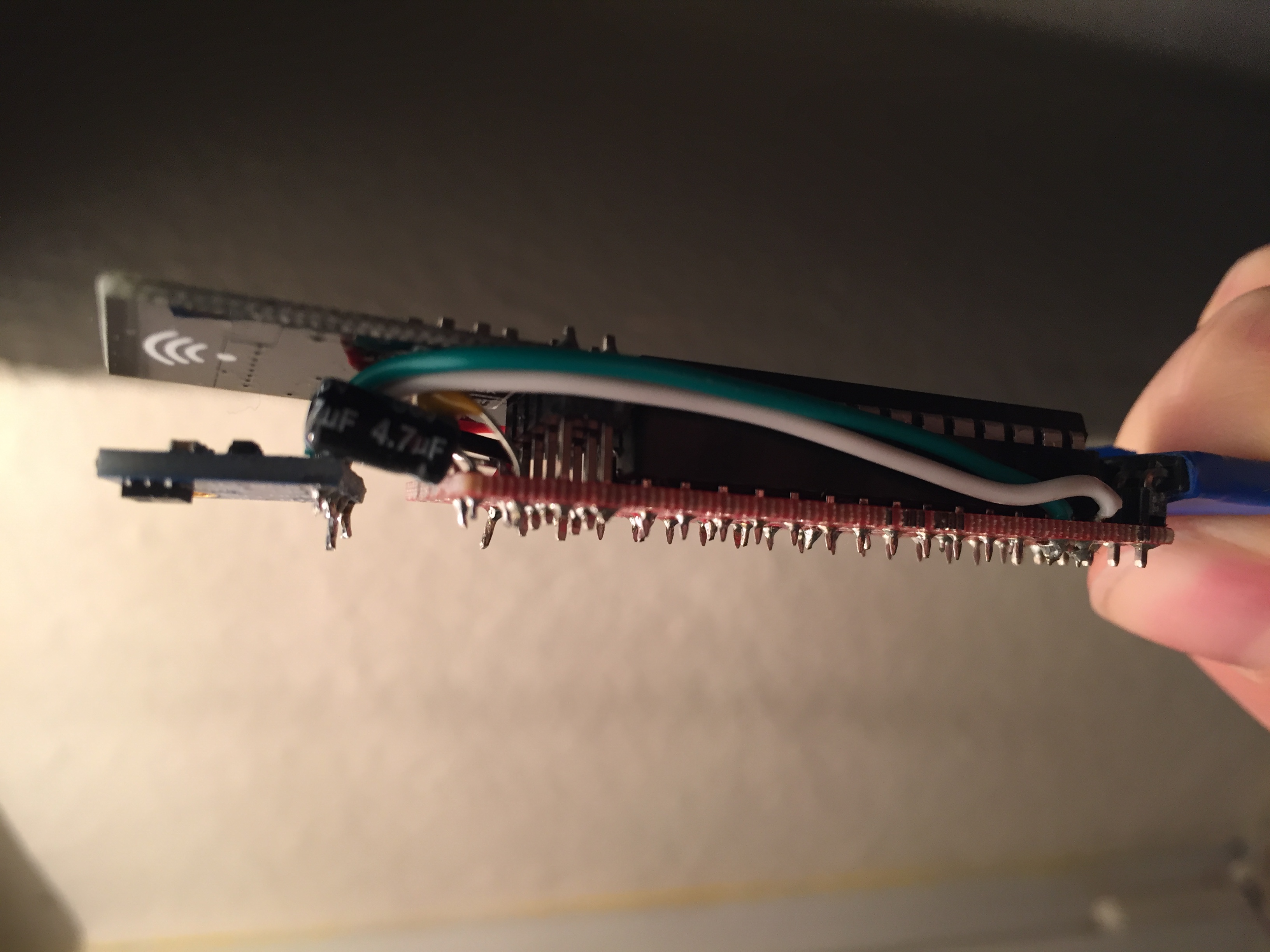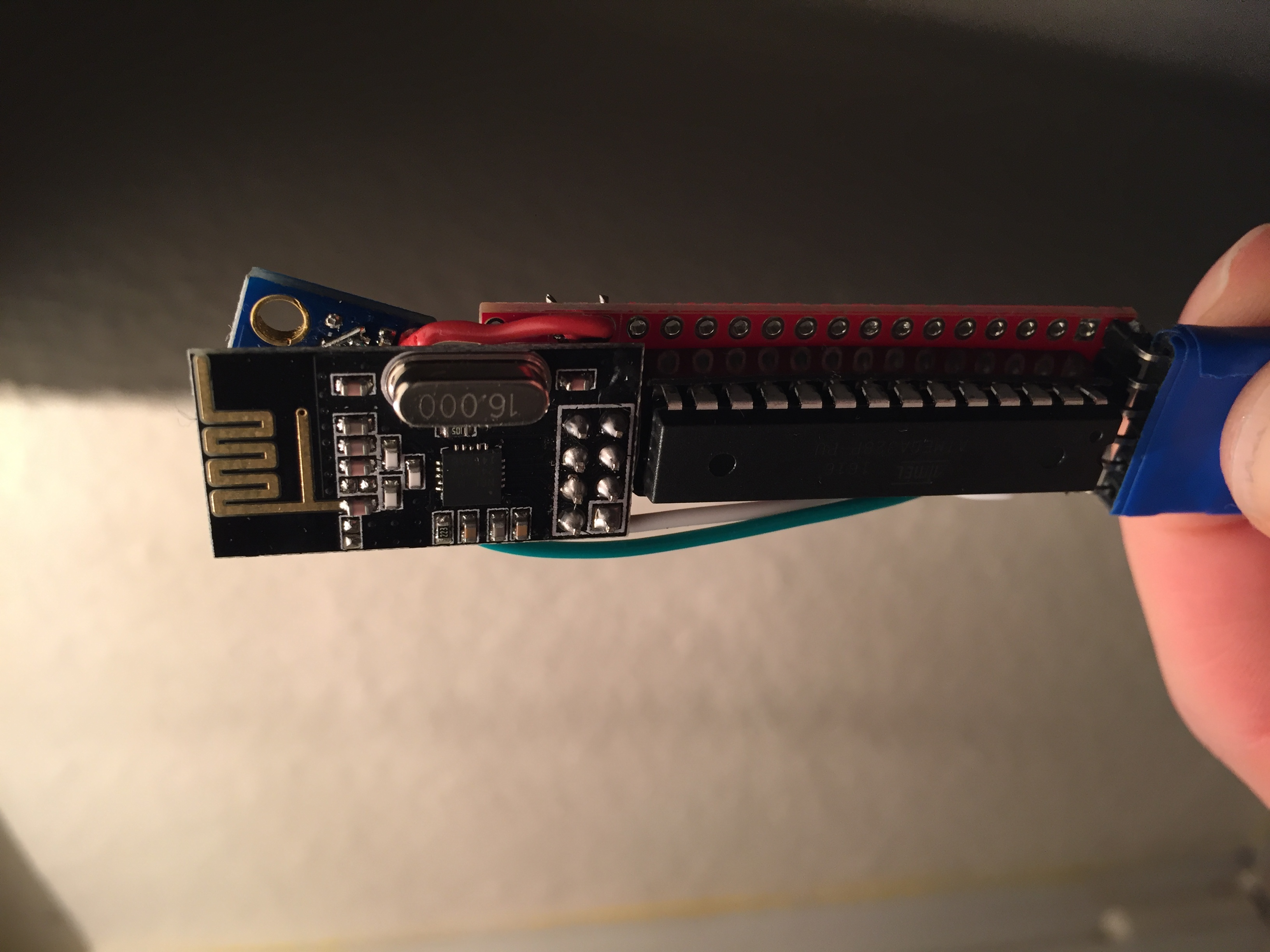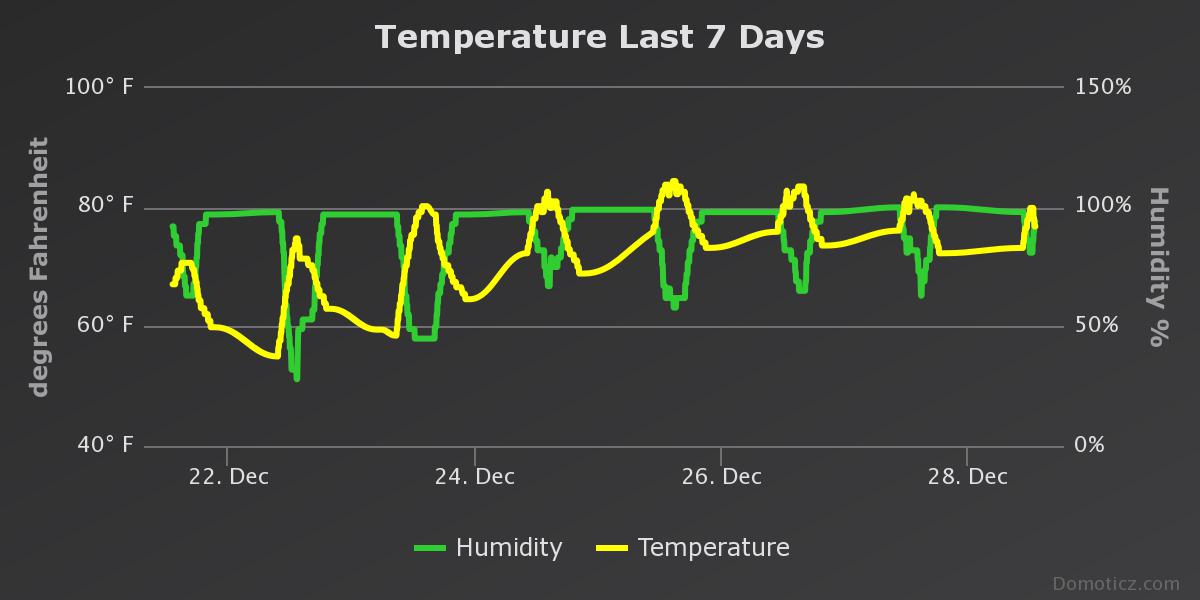Slim Node Si7021 sensor example
-
I am seeing 5.0 μA at sleep and 12.4 mA when transmitting. Seems kind of high. I did the poor man's test as well - put an LED across the HTU21D power pins and it lit up. Same when I did it across the nrf's power pins. Shouldn't the MySensors code turn off the power rails during sleep?
-
I am seeing 5.0 μA at sleep and 12.4 mA when transmitting. Seems kind of high. I did the poor man's test as well - put an LED across the HTU21D power pins and it lit up. Same when I did it across the nrf's power pins. Shouldn't the MySensors code turn off the power rails during sleep?
No, the powerrails are not turned off, just the devices themselves.
5uA during sleep is about right. The 12.4mA during transmit is also normal, but the transmit time should be very short, so on average the total consumption of power will be low.
-
No, the powerrails are not turned off, just the devices themselves.
5uA during sleep is about right. The 12.4mA during transmit is also normal, but the transmit time should be very short, so on average the total consumption of power will be low.
@GertSanders Excellent! I was hoping I hadn't wired it up wrong. So far the 2 nodes have been flawless for the past 3 days. Next step is to await the direct attached NRF serial gateway to be v2 compatible. Been following along with this thread. Looks like we are getting closer! I have 2 RPis (one a first gen B and the other a Pi2 B ) with this adapter by ceech:
https://www.openhardware.io/view/100/Raspberry-PI-NRF24l01-hat -
Hi everyone,
First thanks for sharing. I love this slim node. But I am facing some issues I did not success to debug. So I use the code shared here for mysensors 2. I try with the mysensors exemple library (did not work at all). I try with the https://github.com/LowPowerLab/SI7021 which worked (at least for getting separately temperature and humidity and using the example file) on an arduino nano. But when I run this sensor with the slim node (red, boot loader 8mhz) and the code (for 2.0.0) I always get -46.85 for temperature and 118 for humidity. Otherwise the radio work normally.
Winter is coming and I don't know what I could do anymore. Thanks to share you idea on this.
With the example code I use on the nano. I get with the slim node:
T: -46.85 H: 118 device ID: 50With Arduino nano:
T: 24.34 H: 43 device ID: 50 -
Hi everyone,
First thanks for sharing. I love this slim node. But I am facing some issues I did not success to debug. So I use the code shared here for mysensors 2. I try with the mysensors exemple library (did not work at all). I try with the https://github.com/LowPowerLab/SI7021 which worked (at least for getting separately temperature and humidity and using the example file) on an arduino nano. But when I run this sensor with the slim node (red, boot loader 8mhz) and the code (for 2.0.0) I always get -46.85 for temperature and 118 for humidity. Otherwise the radio work normally.
Winter is coming and I don't know what I could do anymore. Thanks to share you idea on this.
With the example code I use on the nano. I get with the slim node:
T: -46.85 H: 118 device ID: 50With Arduino nano:
T: 24.34 H: 43 device ID: 50 -
@m26872 Sure I can do that. So I simplified the code to only focus on the si7021.
Here it is: https://github.com/clempat/example-si7021
And there the photo:




@clempat Don't think I can help you. Maybe clock related. What voltages do you use on Nano and Slim respectively? Do you have multiple parts to try with and get the same result? Why do you include and start wire.h, isn't already in Si7021.h ? My guess on "device Id 50" is that it's just a chinese clone reply.
Photos look nice btw. :thumbsup: -
@clempat Don't think I can help you. Maybe clock related. What voltages do you use on Nano and Slim respectively? Do you have multiple parts to try with and get the same result? Why do you include and start wire.h, isn't already in Si7021.h ? My guess on "device Id 50" is that it's just a chinese clone reply.
Photos look nice btw. :thumbsup:@m26872 Thank you. Yes I wanted to try with a pro mini 8Mhz but I need to prepare the pin 4 and 5. I will keep inform when I do it this week end.
Thanks for the picture but with this nice setup it is difficult to make it bad :)...
I includes wire.h like in the exemple in https://github.com/LowPowerLab/SI7021 but of course after I tried without. The nano was directly connected to usb and the slim through 3,3V USB to serial.
-
So sad I still not getting it working with the slim node :( !!! Always same result either with internal 1mhz or 8mhz...
-
Hello
I also have big problems with getting the node to send temp and hum values
It starts up and presents itself to the GW but then nothing happensI have tested the SI721 module with a simple arduino code and then it reads and prints both values just fine
My code is below, in practice its a version of Sensebender Micro code. I have changed the force transmit value to 1
Exactly as @clempat I have tried both 1MHz optiboot and 8MHz internal oscillator without any success/** * The MySensors Arduino library handles the wireless radio link and protocol * between your home built sensors/actuators and HA controller of choice. * The sensors forms a self healing radio network with optional repeaters. Each * repeater and gateway builds a routing tables in EEPROM which keeps track of the * network topology allowing messages to be routed to nodes. * * Created by Henrik Ekblad <henrik.ekblad@mysensors.org> * Copyright (C) 2013-2015 Sensnology AB * Full contributor list: https://github.com/mysensors/Arduino/graphs/contributors * * Documentation: http://www.mysensors.org * Support Forum: http://forum.mysensors.org * * This program is free software; you can redistribute it and/or * modify it under the terms of the GNU General Public License * version 2 as published by the Free Software Foundation. * ******************************* * * REVISION HISTORY * Version 1.0 - Thomas Bowman MC8rch * * DESCRIPTION * Default sensor sketch for Sensebender Micro module * Act as a temperature / humidity sensor by default. * * If A0 is held low while powering on, it will enter testmode, which verifies all on-board peripherals * * Battery voltage is as battery percentage (Internal message), and optionally as a sensor value (See defines below) * * * Version 1.3 - Thomas Bowman MC8rch * Improved transmission logic, eliminating spurious transmissions (when temperatuere / humidity fluctuates 1 up and down between measurements) * Added OTA boot mode, need to hold A1 low while applying power. (uses slightly more power as it's waiting for bootloader messages) * * Version 1.4 - Thomas Bowman MC8rch * * Corrected division in the code deciding whether to transmit or not, that resulted in generating an integer. Now it's generating floats as expected. * Simplified detection for OTA bootloader, now detecting if MY_OTA_FIRMWARE_FEATURE is defined. If this is defined sensebender automaticly waits 300mS after each transmission * Moved Battery status messages, so they are transmitted together with normal sensor updates (but only every 60th minute) * */ // Enable debug prints to serial monitor #define MY_DEBUG // Define a static node address, remove if you want auto address assignment //#deine MY_NODE_ID 3 // Enable and select radio type attached #define MY_RADIO_NRF24 //#define MY_RADIO_RFM69 #include <SPI.h> #include <MySensors.h> #include <Wire.h> #include <SI7021-master\SI7021.h> #include <RunningAverage.h> // Uncomment the line below, to transmit battery voltage as a normal sensor value #define BATT_SENSOR 199 #define RELEASE "1.4" #define AVERAGES 2 // Child sensor ID's #define CHILD_ID_TEMP 1 #define CHILD_ID_HUM 2 // How many milli seconds between each measurement #define MEASURE_INTERVAL 60000 // FORCE_TRANSMIT_INTERVAL, this number of times of wakeup, the sensor is forced to report all values to the controller #define FORCE_TRANSMIT_INTERVAL 1 // When MEASURE_INTERVAL is 60000 and FORCE_TRANSMIT_INTERVAL is 30, we force a transmission every 30 minutes. // Between the forced transmissions a tranmission will only occur if the measured value differs from the previous measurement // HUMI_TRANSMIT_THRESHOLD tells how much the humidity should have changed since last time it was transmitted. Likewise with // TEMP_TRANSMIT_THRESHOLD for temperature threshold. #define HUMI_TRANSMIT_THRESHOLD 0.5 #define TEMP_TRANSMIT_THRESHOLD 0.5 SI7021 humiditySensor; // Sensor messages MyMessage msgHum(CHILD_ID_HUM, V_HUM); MyMessage msgTemp(CHILD_ID_TEMP, V_TEMP); #ifdef BATT_SENSOR MyMessage msgBatt(BATT_SENSOR, V_VOLTAGE); #endif // Global settings int measureCount = 0; int sendBattery = 0; boolean isMetric = true; boolean highfreq = true; boolean transmission_occured = false; // Storage of old measurements float lastTemperature = -100; int lastHumidity = -100; long lastBattery = -100; RunningAverage raHum(AVERAGES); /**************************************************** * * Setup code * ****************************************************/ void setup() { Serial.begin(9600); Serial.print(F("Sensebender Micro FW ")); Serial.print(RELEASE); Serial.flush(); humiditySensor.begin(); Serial.flush(); Serial.println(F(" - Online!")); isMetric = getConfig().isMetric; Serial.print(F("isMetric: ")); Serial.println(isMetric); raHum.clear(); sendTempHumidityMeasurements(false); sendBattLevel(false); } void presentation() { sendSketchInfo("TempHum", RELEASE); present(CHILD_ID_TEMP, S_TEMP); present(CHILD_ID_HUM, S_HUM); #ifdef BATT_SENSOR present(BATT_SENSOR, S_POWER); #endif } /*********************************************** * * Main loop function * ***********************************************/ void loop() { measureCount++; sendBattery++; bool forceTransmit = false; transmission_occured = false; if (measureCount > FORCE_TRANSMIT_INTERVAL) { // force a transmission forceTransmit = true; measureCount = 0; } sendTempHumidityMeasurements(forceTransmit); /* if (sendBattery > 60) { sendBattLevel(forceTransmit); // Not needed to send battery info that often sendBattery = 0; }*/ sleep(MEASURE_INTERVAL); } /********************************************* * * Sends temperature and humidity from Si7021 sensor * * Parameters * - force : Forces transmission of a value (even if it's the same as previous measurement) * *********************************************/ void sendTempHumidityMeasurements(bool force) { bool tx = force; si7021_env data = humiditySensor.getHumidityAndTemperature(); raHum.addValue(data.humidityPercent); float diffTemp = abs(lastTemperature - (isMetric ? data.celsiusHundredths : data.fahrenheitHundredths) / 100.0); float diffHum = abs(lastHumidity - raHum.getAverage()); Serial.print(F("TempDiff :"));Serial.println(diffTemp); Serial.print(F("HumDiff :"));Serial.println(diffHum); if (isnan(diffHum)) tx = true; if (diffTemp > TEMP_TRANSMIT_THRESHOLD) tx = true; if (diffHum > HUMI_TRANSMIT_THRESHOLD) tx = true; if (tx) { measureCount = 0; float temperature = (isMetric ? data.celsiusHundredths : data.fahrenheitHundredths) / 100.0; int humidity = data.humidityPercent; Serial.print("T: ");Serial.println(temperature); Serial.print("H: ");Serial.println(humidity); send(msgTemp.set(temperature, 1)); send(msgHum.set(humidity)); lastTemperature = temperature; lastHumidity = humidity; transmission_occured = true; if (sendBattery > 60) { sendBattLevel(true); // Not needed to send battery info that often sendBattery = 0; } } } /******************************************** * * Sends battery information (battery percentage) * * Parameters * - force : Forces transmission of a value * *******************************************/ void sendBattLevel(bool force) { if (force) lastBattery = -1; long vcc = readVcc(); if (vcc != lastBattery) { lastBattery = vcc; #ifdef BATT_SENSOR float send_voltage = float(vcc) / 1000.0f; send(msgBatt.set(send_voltage, 3)); #endif // Calculate percentage vcc = vcc - 1900; // subtract 1.9V from vcc, as this is the lowest voltage we will operate at long percent = vcc / 14.0; sendBatteryLevel(percent); transmission_occured = true; } } /******************************************* * * Internal battery ADC measuring * *******************************************/ long readVcc() { // Read 1.1V reference against AVcc // set the reference to Vcc and the measurement to the internal 1.1V reference #if defined(__AVR_ATmega32U4__) || defined(__AVR_ATmega1280__) || defined(__AVR_ATmega2560__) ADMUX = _BV(REFS0) | _BV(MUX4) | _BV(MUX3) | _BV(MUX2) | _BV(MUX1); #elif defined (__AVR_ATtiny24__) || defined(__AVR_ATtiny44__) || defined(__AVR_ATtiny84__) ADMUX = _BV(MUX5) | _BV(MUX0); #elif defined (__AVR_ATtiny25__) || defined(__AVR_ATtiny45__) || defined(__AVR_ATtiny85__) ADcdMUX = _BV(MUX3) | _BV(MUX2); #else ADMUX = _BV(REFS0) | _BV(MUX3) | _BV(MUX2) | _BV(MUX1); #endif delay(2); // Wait for Vref to settle ADCSRA |= _BV(ADSC); // Start conversion while (bit_is_set(ADCSRA, ADSC)); // measuring uint8_t low = ADCL; // must read ADCL first - it then locks ADCH uint8_t high = ADCH; // unlocks both long result = (high << 8) | low; result = 1125300L / result; // Calculate Vcc (in mV); 1125300 = 1.1*1023*1000 return result; // Vcc in millivolts } -
It would be interesting if someone with issues also tried older versions of libs for Si7021 and/or MySensors.
-
So, after a few months of 2 nodes up and running using the HTU21D sensor I have come the conclusion that the HTU21D is no good for where I live. Lately it has been getting cooler outside (down to mid 50s F) but humidity is still high. As the evening progresses the humidity gets to 100% and the node no longer sends data. This happens around 6pm every day (about half and hour after sunset). It then comes back online at about 10 am the next day. The node that I have inside does not have this issue (same shipment of arduino, pcb, and HTU21D sensors and the same arduino code). Both running off of fresh AAs. May need to upgrade to the SI7021 for outside node.
Here is the graph showing last 7 days. As you can see it flatlines (literally!) at 100% humidity!

All good times with the learning!
-
So, after a few months of 2 nodes up and running using the HTU21D sensor I have come the conclusion that the HTU21D is no good for where I live. Lately it has been getting cooler outside (down to mid 50s F) but humidity is still high. As the evening progresses the humidity gets to 100% and the node no longer sends data. This happens around 6pm every day (about half and hour after sunset). It then comes back online at about 10 am the next day. The node that I have inside does not have this issue (same shipment of arduino, pcb, and HTU21D sensors and the same arduino code). Both running off of fresh AAs. May need to upgrade to the SI7021 for outside node.
Here is the graph showing last 7 days. As you can see it flatlines (literally!) at 100% humidity!

All good times with the learning!
-
@m26872 & @bjacobse - Yes, 100% humidity is normal here. Good old Florida! My concern is that the node stops reporting. Possibly due to condensation shorting out something. During the summer here we also hit 100% humidity but it is also a lot hotter (high 90s). Now, I think that the cooler temps are forcing a dew point that is allowing water to condense on the node. Then during the morning it drys out and resumes transmitting. I would like to find a way to stop this.
-
@m26872 & @bjacobse - Yes, 100% humidity is normal here. Good old Florida! My concern is that the node stops reporting. Possibly due to condensation shorting out something. During the summer here we also hit 100% humidity but it is also a lot hotter (high 90s). Now, I think that the cooler temps are forcing a dew point that is allowing water to condense on the node. Then during the morning it drys out and resumes transmitting. I would like to find a way to stop this.
